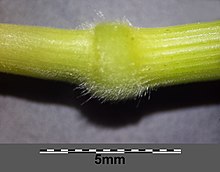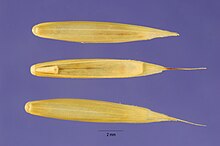Fieder-Zwenke
| Fieder-Zwenke | ||||||||||||
|---|---|---|---|---|---|---|---|---|---|---|---|---|

Feather Zwenke ( Brachypodium pinnatum ) |
||||||||||||
| Systematics | ||||||||||||
|
||||||||||||
| Scientific name | ||||||||||||
| Brachypodium pinnatum | ||||||||||||
| ( L. ) P.Beauv. |
The pinnate Zwenke ( Brachypodium pinnatum ), more precisely called common pinnate Zwenke , is a species of the genus Zwenken ( Brachypodium ) within the sweet grass family (Poaceae). It is a competitive root-creeping pioneer and primarily colonizes poor locations.
description
Vegetative characteristics
The Fieder-Zwenke is a perennial herbaceous plant that reaches heights of 40 to 100, sometimes up to 120 centimeters. It forms loose to dense clumps and spreads with wiry, scaly, subterranean runners ( rhizomes ). The unbranched stalks are bare.
The leaf sheaths are rounded on the back and also mostly bald, the lower ones can also be slightly hairy. The membranous and blunt ligule (ligula) is up to 2 millimeters long and has finely ciliated at the edge. The slightly hairy leaf blades are up to 45 centimeters in length and 2 to 6, rarely up to 10 millimeters in width, flat-linear or rolled up and from yellow-green to olive-green in color. They are gradually finely pointed, flaccid, unevenly ciliated on the edge, rough on the side and rough and dull on the underside due to numerous spiky hairs.
Generative characteristics
The flowering period extends from June to August. The upright or sometimes nodding, racemose inflorescence is spike-like and 4 to 25 centimeters long. 3 to 15 spikelets sit alternately on two opposite sides of the inflorescence axis. The inflorescence axis is thin, the stalks are 1 to 2 millimeters long. The greenish or yellowish spikelets are 2 to 4 centimeters in length, rarely more, cylindrical, lanceolate or narrowly elongated and contain eight to twenty-two flowers. The flowers are usually single or in clusters of two to three. They break under the lemmas when ripe . The glumes are lanceolate to narrowly ovate. They are pointed, rounded on the back and hairless. The lower reaches 3 to 5 millimeters in length and has three to six nerves; the upper one is 5 to 7 millimeters long and has five to seven nerves. The seven-veined, smooth and hairless, rarely short-haired, lemmas overlap and are also rounded on the back. They are elongated, pointed, 6 to 10 millimeters long and have a fine 1 to 5 millimeter long awn at the tip . The palea are as long as the lemma. The two keels are covered with very fine hair.
The number of chromosomes is 2n = 28, less often 14, 16, 18, 20 or 36.
Occurrence
The distribution area extends from Europe to Mongolia and from the Mediterranean area to Iran and Eritrea . Neophytic occurrences are found in New Zealand and North America . In Germany mainly in the central part and in the south up to the mountains up to altitudes of 1600 meters. The species is rare or absent in the north of the Federal Republic of Germany. In the Allgäu Alps in Bavaria, it rises on the Schlappoltkopf near the summit up to 1920 meters above sea level.
The plumage grows often and gregariously in lime-poor grasslands and on extensively managed pastures , on roadsides and in open forests in open ground. It prefers moderately fresh, low-nitrogen, base-rich, mostly calcareous, moderately acidic, humus-rich loam and loess soils .
The Brachypodium pinnatum is the Kennart the class Festuco-Brometea (dry, semi-dry grasslands, basiphile lean lawn) with focal deposits in association Cirsio-Brachypodion and in association Mesobromion erecti. Furthermore, it has a main occurrence in the sub-group Cephalanthero-Fagenion within the mesophytic , beech forest-like deciduous forests of Europe (Fagetalia sylvaticae). Further main occurrences are plant communities of the associations Erico-Pinion, Geranion sanguinei and dry forms of Molinion caeruleae and the order Nardetalia.
It is a half shade to half light plant. It does not bloom in shady locations. It grows mainly on soils that are poor in nitrogen to moderately nitrogenous. It is also a moderate heat pointer, that is, it has a heavy weight in submontane temperate areas in the heat gradient from the cold snow-covered (nival) altitude level to warm lowlands.
Hazard and protection
The Fieder-Zwenke is considered not endangered worldwide and enjoys no legal protection. However, it is listed in the Red Lists of Endangered Vascular Plants of the federal states of Hamburg and Schleswig-Holstein as threatened with extinction.
ecology
The Brachypodium pinnatum is from cattle not eaten due to the rough leaves, so it is able to other grass species, especially the Upright brome ( Bromus erectus to displace). Goats, on the other hand, like to eat the plumage.
Because of its rhizomes that penetrate deeply into the earth, it is well protected against fires that sometimes occur. Shortly after a fire, it can sprout again from the underground survival organs and thus quickly colonize areas freed by competing species. It also helps to consolidate the ground and reduces erosion . In fallow land on limestone grassland, their stalks and leaves, which are difficult to decompose, lead to matting of the sward and thus to a decline in species that need light.
swell
literature
- Henning Haeupler, Thomas Muer: picture atlas of the fern and flowering plants of Germany . Ed .: Federal Agency for Nature Conservation (= The fern and flowering plants of Germany . Volume 2 ). Eugen Ulmer, Stuttgart (Hohenheim) 2000, ISBN 3-8001-3364-4 .
- Charles Edward Hubbard: Grasses. Description, distribution, use (= UTB . Volume 233 ). 2nd, revised and expanded edition. Eugen Ulmer, Stuttgart (Hohenheim) 1985, ISBN 3-8001-2537-4 (English: Grasses . Translated by Peter Boeker).
- Ernst Klapp , Wilhelm Opitz von Boberfeld : Paperback of the grasses . Recognition and determination, location and socialization, evaluation and use. 12th revised edition. Paul Parey, Berlin / Hamburg 1990, ISBN 3-489-72710-X .
Individual evidence
- ↑ a b Brachypodium pinnatum (L.) P. Beauv., Fieder-Zwenke. In: FloraWeb.de.
- ^ Erich Oberdorfer : Plant-sociological excursion flora for Germany and neighboring areas . 8th edition. Stuttgart, Verlag Eugen Ulmer, 2001. ISBN 3-8001-3131-5 . Page 218.
- ↑ Rafaël Govaerts (Ed.): Brachypodium pinnatum. In: World Checklist of Selected Plant Families (WCSP) - The Board of Trustees of the Royal Botanic Gardens, Kew . Retrieved June 18, 2020.
- ↑ Erhard Dörr, Wolfgang Lippert : Flora of the Allgäu and its surroundings. Volume 1, IHW, Eching 2001, ISBN 3-930167-50-6 , p. 207.
- ↑ Gerold Rahmann: Possibilities and limits of the use of the undergrowth of sloping orchards by goats In: Quo vadis Streuobst? Berlin: Naturschutzbund, 2004, pp. 52–65. PDF.
further reading
- P. Catalán, RG Olmstead: Phylogenetic reconstruction of the genus Brachypodium P. Beauv. (Poaceae) from combined sequences of chloroplast ndhF gene and nuclear ITS. In: Plant Systematics and Evolution , Volume 220, 2000, pp. 1-19.
- P. Catalan, Y. Shi, L. Armstrong, J. Draper, CA Stace: Molecular phylogeny of the grass genus Brachypodium p-beauv based on RFLP and RAPD analysis. In: Botanical Journal of the Linnean Society , Volume 117, 1995, pp. 263-280.
- Y. Shi, J. Draper, CA Stace: Ribosomal DNA variation and its phylogenetic implication in the genus Brachypodium (Poaceae). In: Plant Systematics and Evolution , Volume 188, 1993, pp. 125-138.
Web links
- Fieder-Zwenke . In: BiolFlor, the database of biological-ecological characteristics of the flora of Germany.
- Profile and distribution map for Bavaria . In: Botanical Information Hub of Bavaria .
- Brachypodium pinnatum (L.) P. Beauv. In: Info Flora , the national data and information center for Swiss flora . Retrieved September 24, 2015.
- Distribution in the northern hemisphere from: Eric Hultén, Magnus Fries: Atlas of North European vascular plants. 1986, ISBN 3-87429-263-0 at .html Den virtuella floran.
- Thomas Meyer: Data sheet with identification key and photos at Flora-de: Flora von Deutschland (old name of the website: Flowers in Swabia )
- Shou-liang Chen, Sylvia M. Phillips: Poaceae Tribe Brachypodieae. : Brachypodium pinnatum , p. 369 - the same text online as the printed work , In: Wu Zheng-yi, Peter H. Raven, Deyuan Hong (ed.): Flora of China. Volume 22: Poaceae , Science Press and Missouri Botanical Garden Press, Beijing and St. Louis 2006, ISBN 1-930723-50-4 .
- Data sheet Brachypodium pinnatum (L.) P.Beauv. - Tor-grass with distribution map in the Flora of Northern Ireland. (in English )








